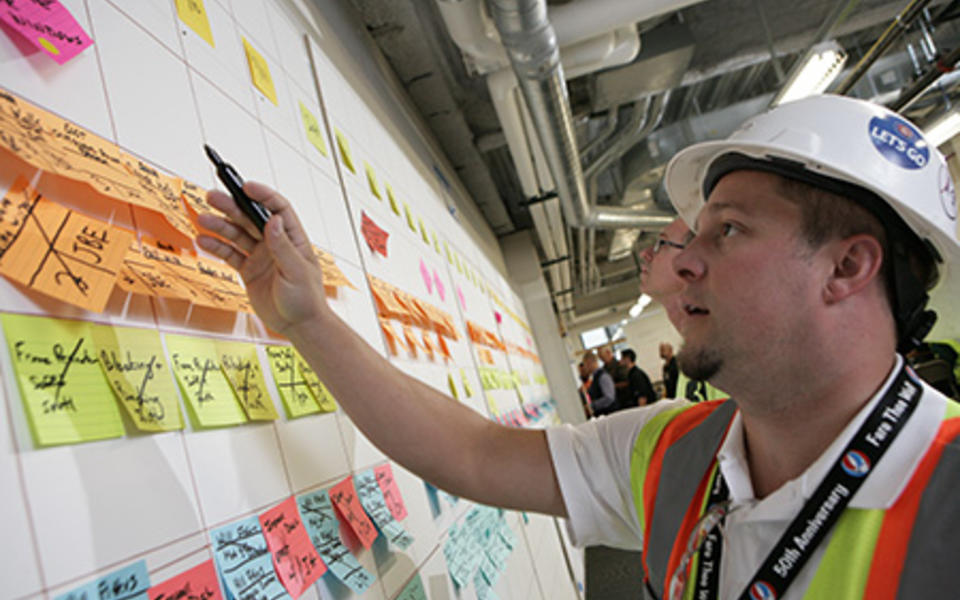Quality, Lean Construction
How lean improves quality
Back in 2011, I was asked to do some research on this new “trend” called lean construction. I knew that it was more than a trend and that it could be very beneficial to our projects and our company. While lean was not my primary role, as the director of quality management, I could see that the principles are closely tied to quality so I took a personal interest in learning more. Since then, I’ve been an advocate and champion for lean at Pepper.
The priorities on all of our projects are schedule, budget, safety and quality. While quality is always a desired outcome, when decisions need to be made in the field, it isn’t always factored into the equation. Lean has helped bring quality into the equation upfront.
Tying quality to what we already do
During pull planning we include safety and quality milestones so when, for example, the team is discussing logistics, we have a conversation about which type of scaffolding makes sense. We want it to be safe, and we want to have the best setup for a quality installation.
It also ensures we plan appropriately for quality coordination meetings for the different systems, like the building envelope, according to the start dates and the sequence they will be working. The trade foremen may think of a more efficient way of sequencing a particular area that will benefit the entire project. Making the quality discussion part of the schedule not only ensures we include time for quality but also places responsibility for it on those who will be doing the work.
Besides pull planning
As Vice President of Technical Services Jen Suerth mentioned in her post last week, virtual design and construction (VDC) is a big part of lean. It helps with visualization, and particularly with the trades’ ability to think through the details and understand how the job will get built before they start the work.
It helps teams look for different approaches and opportunities to improve the process and outcome. It also allows them to “see” the details prior to fabrication. Therefore, if they have any constructability or material compatibility issues, they can address them earlier – before tradespeople start the installation.
Because we see the value of VDC and visual communication to quality outcomes, we’ve been pushing ourselves to do more. How can we do more modeling and include more details? How can we help the trades appreciate the value in this? How can we encourage innovation with our trades?
Daily conversations
Lean construction starts with our teams. Utilizing lean practices means we ask for our trade partners’ input instead of dictating the plan to them. Since we started incorporating lean into our projects, I’ve watched it evolve how we communicate. Particularly in the field, our project teams understand the importance of getting input from the people who will be doing the work.
Daily huddles set this tone. These meetings are two-way conversations, where we talk about what’s going on, what’s coming up and how can we help each other accomplish the work.
For example, our team may start by talking about an expected delivery for which we need a clear path or the need to shut down an area due to an overhead crane load. Then, we talk about how that is going to affect everyone else’s productivity and ways we can keep everyone working.
How does this translate to quality? In the huddle that day, the team can talk about verifying that the in-wall scopes, such as plumbing, electrical and blocking, have completed their installations and that inspections are completed before that drywall is hung. Engaging everyone in that final quality check ensures the installation is correct and complete so drywall doesn’t have to be removed later.
Collaboration. Period.
Lean construction comes down to collaboration. Period. When we’re working through scopes of work and constructability reviews during our pre-installation meetings, we’re promoting collaboration and conversations between the trades. When we’re setting up the schedule to include the necessary quality procedures, we’re collaborating on what needs to be included and when. When we’re talking in our daily huddles about how one trade’s scope could affect another, it encourages collaborative problem-solving. And when we ask the trades to communicate with all of their tradespeople and not just the ones in the office trailer, it extends that collaboration to everyone onsite.
The end goal of lean is value, and we have found that value is always tied to quality. Owners always expect a quality project, whether they explicitly say it or not. Lean construction is an effective approach to look harder at the details, raise awareness with the trades and build more quality stop-gaps into the job - before people start working.
About the Author






